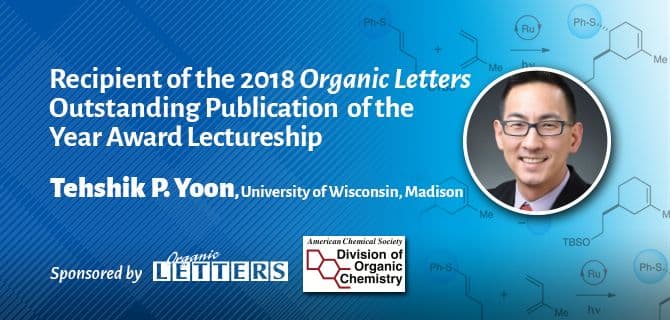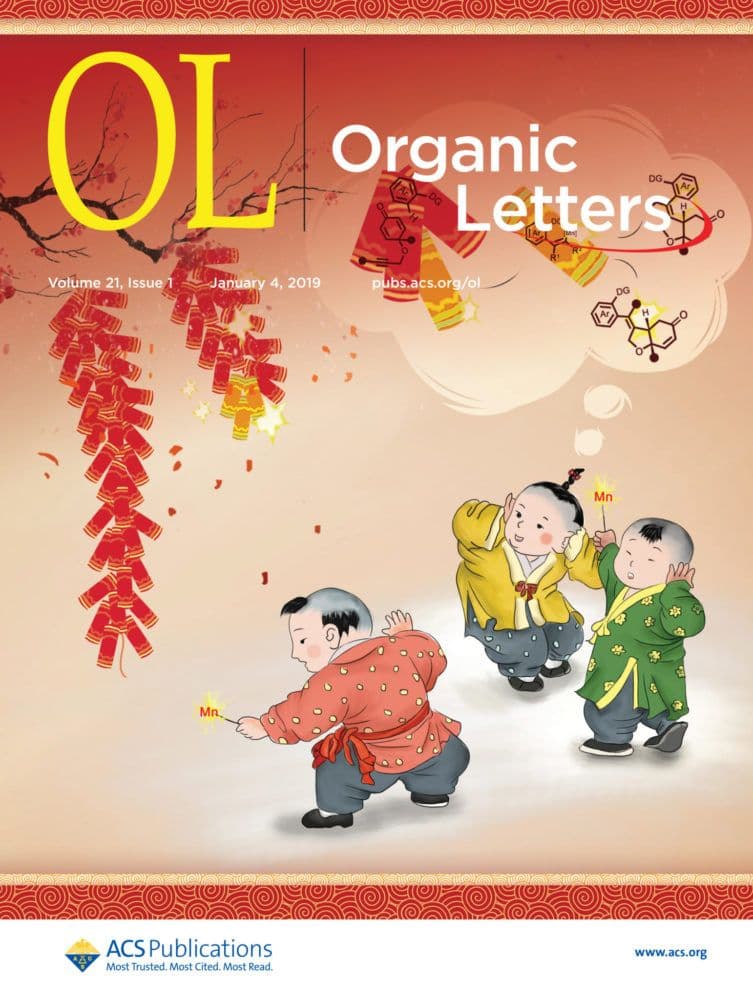Tehshik P. Yoon, Professor in the Department of Chemistry at University of Wisconsin, Madison, is the winner of the 2018 Organic Letters Outstanding Publication of the Year Award Lectureship.

Tehshik P. Yoon, Professor in the Department of Chemistry at University of Wisconsin, Madison, is the winner of the 2018 Organic Letters Outstanding Publication of the Year Award Lectureship. This award honors the author of an outstanding letter published in the previous calendar year that demonstrates creativity and impact in the field of organic chemistry, and is sponsored by Organic Letters and the ACS Division of Organic Chemistry.
“The 2018 Organic Letters Outstanding Publication by Tehshik Yoon entitled ‘Radical Cation Cycloadditions Using Cleavable Redox Auxiliaries‘ provides an elegant new synthetic tactic to access both Diels-Alder and [2+2]-cycloadducts from vinyl sulfides exploiting visible-light-photoredox catalysts,” said Organic Letters Editor-in-Chief Amos B. Smith, III.
“By introducing an electron-rich redox auxiliary, the author turned an otherwise unactivated alkene into an oxidizable substrate under mild conditions,” Smith said. “Importantly, the activating sulfide can then be readily removed to permit access to diverse four- and six-member ring structures. As such, this new synthetic protocol solved a common substrate limitation in radical cation cycloadditions and is likely to inspire related efforts in many laboratories interested in complex molecule synthesis.”
Read all of Tehshik P. Yoon’s articles from ACS Publications.
As winner of Organic Letters Outstanding Publication of the Year Award Lectureship for 2018, Yoon will receive a $3,000 honorarium and travel and hotel accommodations to attend and a present at an ACS Division of Organic Chemistry symposium in his honor at the 256th ACS National Meeting & Exposition in Boston. The symposium will also celebrate Masayuki Inoue, winner of The Journal of Organic Chemistry Outstanding Publication of the Year Award Lectureship for 2018.
An Interview with Tehshik P. Yoon
I recently caught up with Yoon to learn more about his research and what excites him about organic chemistry. Here are the highlights of our conversation.
Radical-based reaction chemistry has a long tradition in organic synthesis, but chemists seemed to have drifted away from this strategy. Now we are hearing more about a renewed interest in the application of radical ion chemistry, such as in your award-winning paper. What’s the story behind this resurgence?
Certainly one reason that radical chemistry has become so much more popular among synthetic chemists recently is the availability of new methods for controllably generating free radical intermediates. Photoredox catalysis is one that is obviously quite dear to me, but there are several purely chemical methods for radical generation that have been developed in the past few decades are similarly more convenient than some more classical methods.
Just as important, however, has been the work been geared towards better understanding the principles of radical reactivity. There have been some long-standing misconceptions that needed to be dispelled before non-experts would embrace organoradical chemistry. For example, it was once “common knowledge” that radical intermediates were so intrinsically reactive that highly enantioselective radical reactions would never be achieved. But Sibi, Curran, and others showed that there’s nothing about radical reactivity that precludes high stereoselectivity.
We are now a lot more comfortable thinking about radical reactions due to the physical and mechanistic groundwork that was laid by the organoradical community. What we are seeing now is a consequence of synthetic organic chemists’ increased ability to creatively apply these principles to useful synthetic processes.
Your group has been developing the concept of a “redox auxiliary” to help overcome some of the energy limitations in this type of light-driven catalytic reaction. Can you explain that to us in layman’s terms, and how this is helping chemists synthesize new molecules for different applications?
Photoredox catalysis works by promoting electron transfer from or to an organic substrate; the resulting radical intermediates possess a diverse reactivity that can be harnessed to generate a wide range of new organic products. But a consequence of this strategy, then, is that substrates that have a hard time participating in the initiation redox step cannot participate in photoredox reactions.
A “redox auxiliary” is a functional group that can be temporarily installed into an otherwise unreactive substrate, can make electron transfer easier, and then can be removed in a high-yielding subsequent step. So this strategy helps to overcome an intrinsic limitation in scope facing any reaction initiated by electron transfer.
If you could look to the future, what effect do you think this research is going to have on the chemistry community and on society?
My laboratory thinks quite a lot about how we might address some of the limitations of photoredox chemistry, and one of the most fundamental of these limitations is the thermodynamics of the key electron-tranfer step. We devised the redox auxiliary strategy as a convenient work-around that lets us temporarily modify the electrochemical properties of an organic substrate. This idea has the potential to be quite general.
First, I hope that others borrow the concept in designing their own new photoredox reactions that can activate new kinds of substrates in new and more complex bond-forming reactions. More broadly, I hope the concept of a redox auxiliary becomes adopted in other kinds of organic reactions where electron transfer is an important activation step. For instance, synthetic chemists seem to be increasingly interested in electrochemical methods. I don’t see any reason why redox auxiliaries could not also be enabling in those contexts as well.
What are the next steps in your research?
One unifying theme in a lot of our research is the question that this communication posed: How do you overcome the thermodynamic limitations inherent to electron transfer as an activation step in photoredox catalysis?
The idea in this paper is to change the properties of the substrate.We’ve also studied modifications to the photoredox catalyst that adjust its redox potential, and this continues to a central interest in our laboratory. Finally, we’re thinking about what else a photocatalyst can do to activate a substrate besides electron transfer.
A central theme of our research at the moment is developing catalytic strategies to control energy transfer reactions. This is exciting because the reactivity accessible using energy transfer is quite different from the kinds of reactions we can perform through electron transfer. It’s been a great deal of fun.
Is there anything else you’d like to share?
I’m really grateful for this award because it recognizes the hard work and creativity of the students who are co-authors on this project. The idea that I sketched out when I first proposed the idea bears little resemblance to the finished product. This is true of all good papers of course, but it is especially true of this project! I am fortunate to work with an exceptional team of students and postdocs who keep me inspired.
